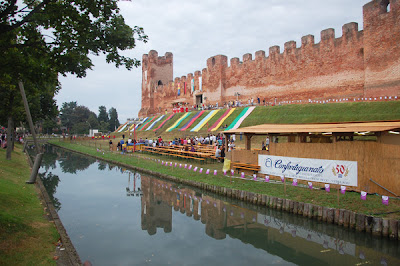Every Spring and Fall, communities around the mountainous regions of Italy--the communities around the Alps and the Apennines, specifically--celebrate the departure of cattle for the greener mountain pastures in the Spring and the milder winters of the plains in the Fall. This constant movement of livestock has been enacted even before the Romans came around, and many communities to this day still celebrate the day their cows and sheep return.
Sunday, September 25, 2011
Saturday, September 24, 2011
Sarajevo on My Mind
Reading this article reminded me of a quote from Safe Area: Gorazde of a Bosniak partier's reason for having so much fun in the midst of a bloody and seemingly endless war: "We don't party like there is is no tomorrow. We party because there is a tomorrow." It really demonstrates the resilience of the Bosniaks who, having gone through so much during the wars of the early 90s, chose to celebrate not the end of a conflict, but the continuation of life as it was.
Labels:
bosnia,
gorazde,
guiness,
sarajevo,
sarajevsko
Tuesday, September 20, 2011
Sagra di Bosco di Nanto
Catching the tail end of Bosco di Nanto's sagra, we honestly didn't know what to expect. What would they serve? Would it be busy? What kind of entertainment would they have? Little did we know, none of it mattered. Except for one: our introduction to the Italian urban cowboy.
Labels:
berico hills,
bosco di nanto,
colli berici,
line dancing,
sagra,
tripe,
trippa,
trippa alla parmigiana
Tuesday, September 13, 2011
Dog Goes Boating
This past weekend was a long weekend for Vicenza, celebrating the 300th-or so year anniversary of an apparition of the Virgin Mary in Monte Berico that ended a terrible plague. Devotees walk from the base of the hill all the way to the Santuario della Madonna to offer their prayers. Below, citizens flock to the city center to enjoy the luna park and the fun energy in general.
For me however, the 8th and the 9th were workdays. So the weekend had to be an away weekend to avoid the feeling of depression borne out of having to work when everyone else gets a vacay. So, I packed a tent, some sleeping bags, and some meat for the grill and headed out to my favorite lake, Lago di Ledro. Above was the pooch, enjoying a bit of sun while we rotate peddling duties for the boat. I overly underestimated the pedal boat: mostly relegated to artificial lakes in city parks, I thought it would be boring and relatively limited to within a few meters from the shore. But it was the little boat that could: it chugged along effortlessly from one end of the lake to another and safely accommodated two peddlers and two sunbathers. Mixed with a bit of sun bathing and swimming (not me—the water was too cold and I was born in the tropics), it was the perfect, relaxing weekend.
Sunday, September 4, 2011
Palio of Castelfranco Veneto
Our recent trip to Castelfranco was largely a chance encounter, the result of a search for a new diversion after Treviso proved largely a bore. I have been to the small, walled town before, to see the Giorgione exhibit which brought together all of the master's known works for the first time (including the town's own, "Castlefranco Madonna," which is housed in the town's cathedral). This time around, I witnessed an example of one of the country's more typical autumn celebrations: the medieval festival.
Labels:
castelfranco veneto,
medieval festival,
palio,
treviso,
walled town
Saturday, September 3, 2011
Villas of the Veneto: Villa Valmarana ai Nani (Vicenza)
Only a few steps away from the church in Monte Berico and Palladio's masterpiece the Rotonda, Villa Valmarana ai Nani is certainly not an attention seeker. Within the compounds, protected by high walls topped with statues of dwarves, is a modest villa with no striking feature other than a disproportionately small pediment and a grand view of Colli Berici. Inside, however, are the Tiepolos' Rococo masterpiece.
Labels:
baroque,
monte berico,
rococo,
tiepolo,
vicenza,
villa valmarana ai nani,
villas,
villas of the veneto
Movies in Italy: Lo sceicco bianco (Federico Fellini, 1952)
In Fellini's early critique of patriarchal Italy, a couple, Ivan and Wanda, travels to big-city Rome for their honeymoon, to meet Ivan's extended family, and to meet the pope. It's Italian provincialism coming home to roost in its big glittering capital that, for all intents and purposes, operate along the same codes of conduct. The proud Ivan wants everything to be perfect so that his family sees his picture-perfect wife, but Wanda has other plans. When her husband takes a nap, Wanda escapes to the Cinecitta, where she meets her film idol "the White Sheik". However, what was supposed to be a few minutes of fawning turned into hours of discovering the reality behind the film industry, while Ivan spends his time worrying about his family's reputation if they find out that his wife left him for a foreign royalty. Even though the woman is shown as a victim not only of social repression but also the illusions provided as a form of "escape," the husband is ultimately seen as the one who shoulders much of society's demands, trying to coordinate the conflicting wants of his society, family, and wife. Throughout the film, Ivan sports a discombobulated and helpless look, and for much of the film he is reduced to a sobbing boy incapable of maintaining his crumbling world. When he finally reunites with his wife, he goes back to his domineering demeanor as he meets his family in the Vatican, in a symbolic return back to the stability of the family and church.
Labels:
fellini,
lo sceicco bianco,
movies in italy,
rome,
st. paul,
vatican,
white sheik
Friday, September 2, 2011
Subscribe to:
Comments (Atom)








